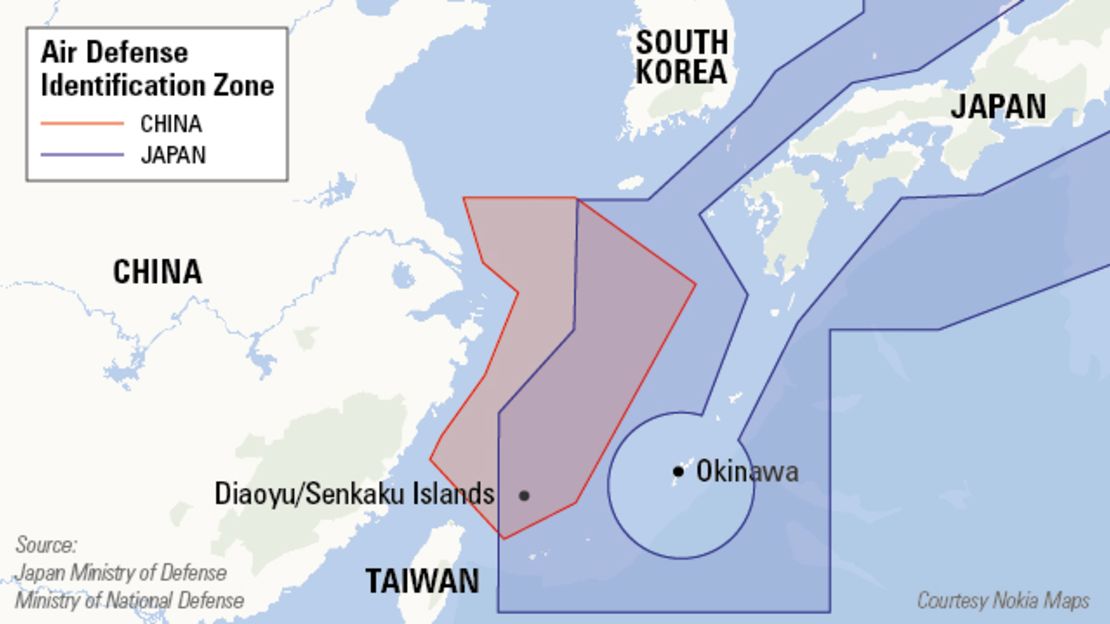Story highlights
China releases a map and coordinates that identify its "Air Defense Identification Zone"
The zone includes disputed islands -- known as Senkaku by Japan and Diaoyu by China
China began air patrols over the zone on Saturday
Defense Secretary Chuck Hagel called the move is an attempt to destabilize the status quo in the region
The United States warned Saturday that China’s military claim to airspace over a disputed island chain creates the risk of “misunderstanding and miscalculation.”
The creation of an “Air Defense Identification Zone” by China, which its top defense official described as an early-warning system, comes amid rising tensions between China and Japan over claims to the islands that are believed to have large oil reserves.
“This unilateral action constitutes an attempt to change the status quo in the East China Sea. Escalatory action will only increase tensions in the region and create risks of an incident,” U.S. Secretary of State John Kerry said.
“…We have urged China to exercise caution and restraint, and we are consulting with Japan and other affected parties throughout the region.”

READ: How Japan is using YouTube in islands dispute
The dispute over the islands – known as the Senkaku Islands by Japan and the Diaoyu by China – has strained relations between the two countries. The islands are close to strategically important shipping lanes and their legal owners would also have the right to the rich marine life in surrounding waters.
Even as China’s Ministry of National Defense said the new air defense zone was not directed toward a specific country, it released a map and coordinates that shows the zone covers most of East China Sea, as well as the islands.
“This is a necessary measure taken by China in exercising its self-defense right,” Col. Yang Yujun said in remarks posted on the ministry website. “It is not directed against any specific country or target. It does not affect the freedom of over-flight in the related airspace.”
The Chinese defense ministry also said it began patrols of the zone on Saturday.
Japan’s defense ministry said two Chinese planes came within miles of its airspace, prompting authorities to scramble Japanese fighter jets.
It’s the second time this month that Japan has launched fighter jets, alleging Chinese planes appeared to be closing in on its air space.
READ: Chinese plane lets gamers fight over islands
U.S. Secretary of Defense Chuck Hagel called the move by China an attempt to destabilize the status quo in the region, and it “increases the risk of misunderstanding and miscalculations.”
“This announcement by the People’s Republic of China will not in any way change how the United States conducts military operations in the region,” Hagel said.
The disagreement over who owns the islands flared between the two countries in the latter half of 2012.
Protests erupted in China after Japan announced it had bought several of the disputed islands from private Japanese owners. The deal was struck in part to prevent the islands from being bought by Tokyo governor Shintaro Ishihara, who had called for donations for a public fund to buy them.
READ: Asia’s disputed islands – who claims what?
China was outraged, as were protesters who marched through several Chinese cities calling for boycotts of Japanese products and urging the government to give the islands back.
In December 2012, the dispute escalated when Japan scrambled fighter jets after a Chinese plane was seen near the islands. A number of Chinese ships also have entered contested waters despite warnings from the Japanese Coast Guard.
China says its claim extends back hundreds of years. Japan says it saw no trace of Chinese control of the islands in an 1885 survey, so formally recognized them as Japanese sovereign territory in 1895. Japan then sold the islands in 1932 to descendants of the original settlers.
The Japanese surrender at the end of World War II in 1945 only served to cloud the issue further.
The islands were administered by the U.S. occupation force after the war. But in 1972, Washington returned them to Japan as part of its withdrawal from Okinawa.
Taiwan, which Beijing regards as a breakaway province, also lays claim to the islands.
CNN’s Barbara Starr and Tom Dunlavey contributed to this report.









